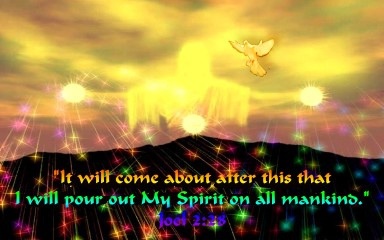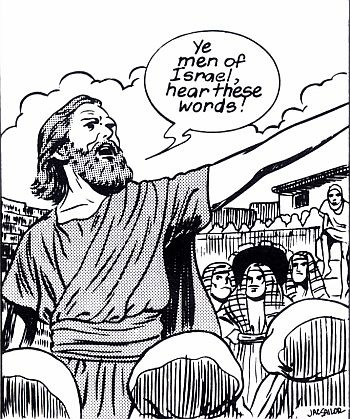Peter's Sermon on the Day of Pentecost

Introduction to Peter's Speech in Acts 2
Throughout much of the New Testament scriptures readers will find that the New Testament is deeply rooted and finds its base in the Hebrew Scriptures, the Old Testament. Not only is the New Testament based upon the Old Testament, the New Testament expounds upon and shows how Jesus fulfills it. There is an interdependence found between the two testaments as St Augustine old maxim states "The Old Testament is the New Testament concealed and the New Testament is the Old Testament revealed"(1). This is particularly obvious in Peter's Speech in Acts chapter 2 verses 14 through 42. In this speech Peter uses the Old Testament scriptures to explain what had just happened when the disciples had been baptized with Holy Spirit and prophecies that foretold of Jesus as Messiah and Lord.
Peter's speech in the book of Acts chapter 2 verses 14 through 42 can be broke down into three parts: 1a) Verses 17 through 21 are drawn from Joel chapter 2 verses 28 through 32; 1b)Verses 22 through 24 is Peter's exegesis or explanation of these verses from Joel chapter 2; 2a) Verses 25 through 28 are drawn from Psalm 16 verses 8 through 11; 2b)Verses 29 through 33 are again an exegesis or explanation of these verses from Psalm 16; 3) Verses 34 through 36 are drawn from Psalm 110 verse 1; And finally 3a) verses 37 through 42 are Peter's summary of his speech as well as a call to repentance and faith in The Lord Jesus Christ.

Acts 2:14-24
In this first section in the books of Acts 2:14-42, the Holy Spirit has come and filled the disciples and they are speaking in tongues and the men in the Temple suppose that the disciples are drunk. Peter begins to correct them by explaining to the multitude that the miracle of tongues that they are witnessing is the fulfillment of Joel 2:18-22, that the last days are here. That this is the visible outpouring of God's Holy Spirit upon men and women referencing the prophet Joel: " that it shall come to pass... That I will pour out my Spirit on all flesh; your sons and daughters shall prophecy and your old men shall dream dreams and your young men shall see visions. Even on the male and female servants in those days I will pour out my Spirit," (Joel 2:28-29 ESV). In acts chapter 2:22-24 Peter explains to the crowd how God began this work through Jesus in his: "mighty works and wonders and signs," (Acts 2:22) referencing Joel 2:30 and discusses Jesus' death, burial, and resurrection
Acts 2:25-33
Acts 2:25-33
In this second section of Acts Chapter 2:14-42, Peter draws upon Psalm 16:8-11 to explain Jesus' resurrection and that King David prophesied Jesus' resurrection in Psalm 16 when David said: "For you will not abandon my soul to Sheol, or let your holy one see corruption," (Ps 16:10 ESV). Peter argues that this scripture could not be talking about David because: "David both died and was buried, and his tomb is with us to this day," (Acts 2:29 ESV). Peter further states that David foresaw that one of his descendants would be set on the throne as promised in 2 Samuel 7:13 and 16 and is thus speaking of Jesus that he would: "not be abandoned in Hades nor his flesh see corruption" (Acts 2:31 ESV) and that Peter and the disciples were all witnesses to the resurrection of Jesus and that is exalted at the right hand of the Father.
Acts 2:34-42
Peter in this third section of his speech in Acts 2:34-42 tells us in verse 33 leading up to this section that Even though Jesus has been resurrected that he is no longer on this earth in his bodily form. Peter begins to describe the ascension of Jesus saying "being therefore exalted at the right hand of God, and having received from the father the promise of the Holy Spirit, He has poured out this that you yourselves are seeing and hearing," (Acts 2:33 ESV). The pouring out of this Holy Spirit is the confirmation that Jesus has ascended into heaven according to Peter and the scriptures. Peter then goes onto another Old Testament Scripture to prove that the messiah would be seated at the right hand of the Father. The scripture that Peter uses is Psalm 110:1: " The Lord said to my Lord: "Sit at my right hand until I make your enemies your footstool"," (Psalm 110:1 ESV). Peter says that again this scripture is not talking about David: " For David did not ascend to into the heavens,"(Acts 2:34 ESV), but he was foretelling of the one who would ascend to heaven and be seated at the right hand of the Father. Peter makes the argument that by Jesus being the one that is seated at the right hand of the Father that The Father gave Jesus authority over all things and that Jesus is both The Lord and the Messiah. In verse 37 it says that Peter's word "cut to the heart" (vs 37) and calls the hearers to repent and believe because of what God has done. This section concludes with 3000 believing in Jesus, being baptized, devoting themselves to the teachings if the apostles and breaking bread together.
Conclusion
Peter's speech in Acts 2:14-42 is just one example of how scripture doesn't stand alone and is interdependent. Had it not been for the prophesies in Psalms 110 and 16 and in Joel 2 the events and Peters speech would not have revealed very much and definitely would not have made much sense. Scripture has a way of using other scripture to further expound upon itself and bring a sense of revelation to the reader as they go through scripture. This small section of scripture is definitely a case in point that the New Testament reveals the meanings of the Old Testament.








